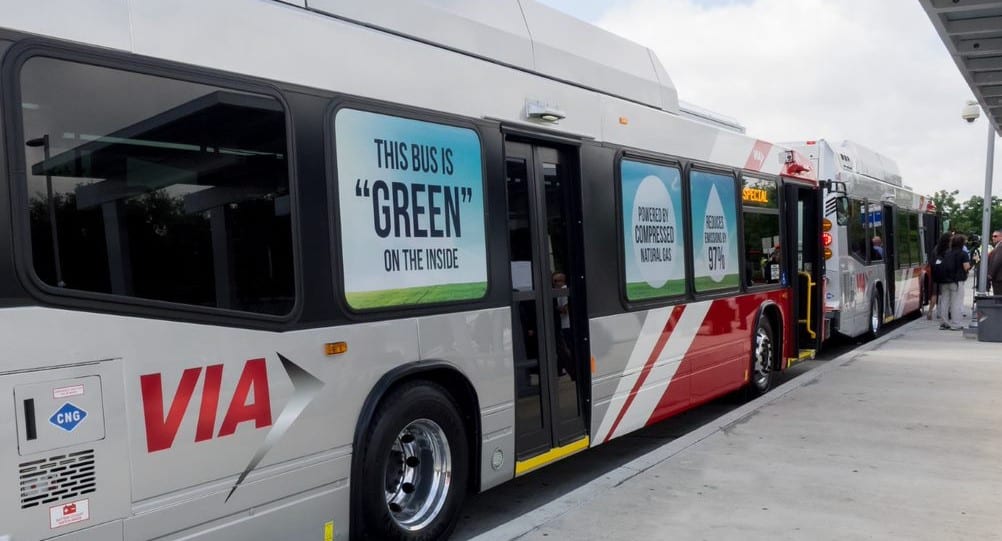In Partnership with: Trillium

VIA Metropolitan Transit, the public transit and mobility network for the City of San Antonio and surrounding Bexar County, has a history of making smart and sustainable investments to keep San Antonio moving. This includes operating a cleaner, more cost-effective fleet of compressed natural gas vehicles fueled via a record-setting CNG station. With Trillium as their fueling partner, VIA currently operates the largest CNG station in North America, fueling the agency’s growing fleet of more than 400 transit buses.
VIA President/CEO Jeffrey C. Arndt first laid the groundwork for the transition from diesel to CNG when he joined the transit agency in 2012. Arndt had 25 years in experience operating CNG buses from his tenure with Houston Metro, having helped lead the transit agency’s move to CNG when the fuel was considered the very latest in cutting-edge clean vehicle technology in the late 1980s.
With Trillium as their fueling partner, VIA operates the largest CNG station in North America, fueling 400 transit buses.
The Decision to Transition to CNG
When Arndt arrived at VIA, he inherited a fleet of aging diesel-fueled buses, most of which were past their useful life. VIA needed to replace most of the fleet with cleaner, more efficient vehicle technology while considering the agency’s operational requirements. With over 6,800 stops operating in a 1,200-square-mile service area, the agency runs more miles per bus than a typical transit agency, meaning when a bus pulls out of the depot at the start of a shift, it stays out all day and does not return to refuel. When VIA’s management team looked at replacing the aging diesel bus fleet, they considered solutions that were both environmentally and economically superior to what VIA had been operating.
Arndt knew firsthand how much the technology for CNG buses had progressed over the course of his tenure with Houston Metro. He worked with VIA’s board of trustees to evaluate options, examining both the CNG and battery-electric alternatives to diesel that existed at that time. CNG checked all the boxes by enabling the agency to reduce vehicle emissions, decrease operating costs and enhance service. As the San Antonio region had been designated an EPA nonattainment area for ozone levels, the emissions benefits of CNG were a critical deciding factor. A fleet of buses running on CNG would be capable of reducing levels of NOx by up to 97% compared to the fleet of older diesel buses they were replacing. VIA was ready to invest heavily in CNG technologies, and after careful planning, began purchasing CNG buses and planning for fueling infrastructure in 2014. By 2020, VIA was on track to complete the conversion of its entire fleet of diesel buses to CNG.
Buses running on CNG reduced NOx by up to 97% compared to the fleet of older diesel buses.
Finding a Fleet-Focused Fueling Partner
When looking for a partner to build and maintain a private CNG fueling station, it was important that VIA find a fuel provider with experience not just supporting fleets but one that understood the specific needs of a transit agency. Trillium provides that expertise and more, with over 20 years of working to design and build customized fueling solutions. Today, Trillium continues to work side-by-side with VIA as it plans for growth and future fueling needs.
“What’s special about VIA is not only their commitment to transitioning their bus fleet to a clean fuel, but also their efforts to be an advocate on behalf of compressed natural gas,” said Ashley Duplechien, senior manager of business development for Trillium. “Their leadership in this space is, no doubt, a major contributing factor to other fleets following through with a transition of their own, resulting in cleaner air in San Antonio as well as elsewhere in the United States.”
Construction on VIA’s CNG fueling station began in the summer of 2016 and was completed in early 2017. With the largest size and capacity in North America, the station has seven 700-horsepower compressors with a total capacity of approximately 10,000 standard cubic feet per minute, or 82 gasoline gallon equivalent per minute. The station contains eight storage vessels with a total of approximately 88,000 standard cubic feet at 4,500 pounds per square inch. The station has 10 fast fill transit dispensers, capable of fueling a 120-gallon tank in under five minutes.
The CNG buses support the city’s sustainability goals, reduce the agency’s operating costs, and improve customer experience.
Delivering Environmental and Financial Benefits
VIA’s costs for fueling with CNG, compared to diesel, dropped almost 70% on a per-mile basis. For the busy transit agency, fuel used to comprise 10 to 12% of its total budget. Now, it is 5% or less, thanks to the lower cost of fueling with CNG. VIA Transit now realizes annual fuel savings of over $8.5 million.
Both grants and incentives played a role in the agency’s successful transition to CNG. For the CNG fueling station, approximately $9 million of the budget was provided by federal grants. Another $80 million has been secured from federal and state grants to help offset the cost of purchasing CNG buses.
VIA made sure to get the message out about lowering its environmental impact when its CNG buses began offering service in San Antonio. The buses are painted red and gray, leading the transit agency to wrap them with the slogan “Red on the outside, Green on the inside.”
The new buses support the city’s sustainability goals, reduce the agency’s operating costs, and improve both driver and rider experience. Customers and riders appreciate that VIA is doing its part to reduce emissions for the community.
To learn more about Trillium’s portfolio of fueling solutions, visit www.loves.com/trillium.


